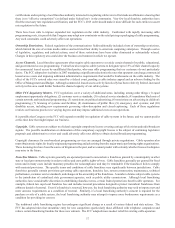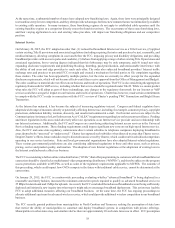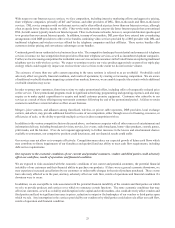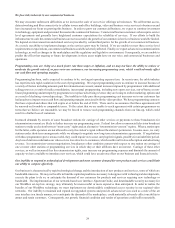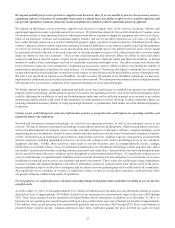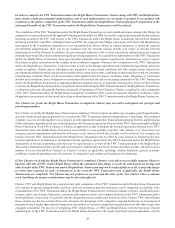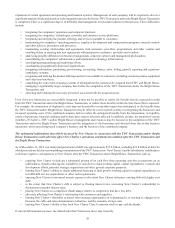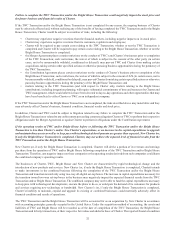Charter 2015 Annual Report Download - page 39
Download and view the complete annual report
Please find page 39 of the 2015 Charter annual report below. You can navigate through the pages in the report by either clicking on the pages listed below, or by using the keyword search tool below to find specific information within the annual report.24
We face risks inherent in our commercial business.
We may encounter unforeseen difficulties as we increase the scale of our service offerings to businesses. We sell Internet access,
data networking and fiber connectivity to cellular towers and office buildings, video and business voice services to businesses and
have increased our focus on growing this business. In order to grow our commercial business, we expect to continue investment
in technology, equipment and personnel focused on the commercial business. Commercial business customers often require service
level agreements and generally have heightened customer expectations for reliability of services. If our efforts to build the
infrastructure to scale the commercial business are not successful, the growth of our commercial services business would be limited.
We depend on interconnection and related services provided by certain third parties for the growth of our commercial business.
As a result, our ability to implement changes as the services grow may be limited. If we are unable to meet these service level
requirements or expectations, our commercial business could be adversely affected. Finally, we expect advances in communications
technology, as well as changes in the marketplace and the regulatory and legislative environment. Consequently, we are unable to
predict the effect that ongoing or future developments in these areas might have on our voice and commercial businesses and
operations.
Programming costs are rising at a much faster rate than wages or inflation, and we may not have the ability to reduce or
moderate the growth rates of, or pass on to our customers, our increasing programming costs, which would adversely affect
our cash flow and operating margins.
Programming has been, and is expected to continue to be, our largest operating expense item. In recent years, the cable industry
has experienced a rapid escalation in the cost of programming. We expect programming costs to continue to increase because of
a variety of factors including amounts paid for retransmission consent, annual increases imposed by programmers with additional
selling power as a result of media consolidation, incremental programming, including new sports services, out-of-home or non-
linear programming and attempts by programmers to replace advertising revenue they are losing to online marketing options and
as a result of declining viewership ratings. The inability to fully pass these programming cost increases on to our customers has
had an adverse impact on our cash flow and operating margins associated with the video product. We have programming contracts
that have expired and others that will expire at or before the end of 2016. There can be no assurance that these agreements will
be renewed on favorable or comparable terms. To the extent that we are unable to reach agreement with certain programmers on
terms that we believe are reasonable, we may be forced to remove such programming channels from our line-up, which could
result in a further loss of customers.
Increased demands by owners of some broadcast stations for carriage of other services or payments to those broadcasters for
retransmission consent are likely to further increase our programming costs. Federal law allows commercial television broadcast
stations to make an election between “must-carry” rights and an alternative “retransmission-consent” regime. When a station opts
for the latter, cable operators are not allowed to carry the station’s signal without the station’s permission. In some cases, we carry
stations under short-term arrangements while we attempt to negotiate new long-term retransmission agreements. If negotiations
with these programmers prove unsuccessful, they could require us to cease carrying their signals, possibly for an indefinite period.
Any loss of stations could make our video service less attractive to customers, which could result in less subscription and advertising
revenue. In retransmission-consent negotiations, broadcasters often condition consent with respect to one station on carriage of
one or more other stations or programming services in which they or their affiliates have an interest. Carriage of these other
services, as well as increased fees for retransmission rights, may increase our programming expenses and diminish the amount of
capacity we have available to introduce new services, which could have an adverse effect on our business and financial results.
Our inability to respond to technological developments and meet customer demand for new products and services could limit
our ability to compete effectively.
Our business is characterized by rapid technological change and the introduction of new products and services, some of which are
bandwidth-intensive. We may not be able to fund the capital expenditures necessary to keep pace with technological developments,
execute the plans to do so, or anticipate the demand of our customers for products and services requiring new technology or
bandwidth. The implementation of our network-based user interface, Spectrum Guide, and downloadable security necessary for
our Worldbox set-top box strategy, may ultimately be unsuccessful or more expensive than anticipated. In order to realize the
benefits of our Worldbox technology, we must implement our downloadable conditional access security in our regional video
networks. Our inability to maintain and expand our upgraded systems and provide advanced services such as a state of the art
user interface in a timely manner, or to anticipate the demands of the marketplace, could materially adversely affect our ability to
attract and retain customers. Consequently, our growth, financial condition and results of operations could suffer materially.





